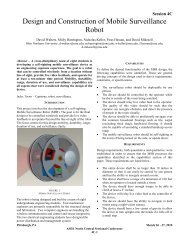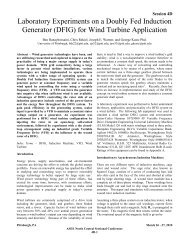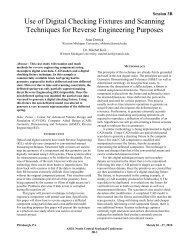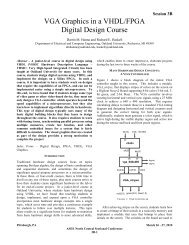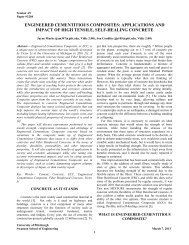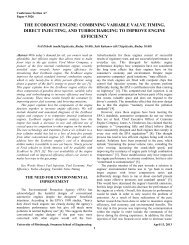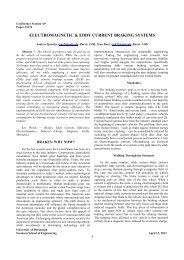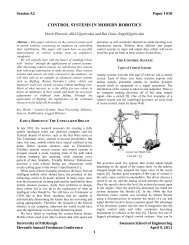Create successful ePaper yourself
Turn your PDF publications into a flip-book with our unique Google optimized e-Paper software.
1118 B9<br />
Apple<br />
Apple Corporation is a pioneer in the field of consumer<br />
electronics. With their innovative designs, Apple products<br />
have been setting new standards to which other technology<br />
is compared. In 2007, Apple revealed the iPhone, changing<br />
the face of telecommunications and touch screen technology<br />
[10]. This device was revolutionary because it incorporated a<br />
cell phone, iPod, and Internet communications device,<br />
making it the only electronic device you need [11]. Apple<br />
also created a version of this device to be the next generation<br />
of iPod, called the iPod <strong>Touch</strong> or the i<strong>Touch</strong>. It is very<br />
similar to the iPhone, except for the difference that it does<br />
not have cell phone capabilities. For our purposes, these<br />
devices will be described as interchangeable, because they<br />
both rely on the same touch technology and the same userinterface<br />
[9].<br />
manipulate documents, images, and other files with motions<br />
that feel like the task actually being completed, the user is<br />
able to work more efficiently and with less specific training<br />
or knowledge.<br />
Apple recently announced their next step in the field of<br />
touch screen technology: the iPad. Little is known about this<br />
device, aside from general technical descriptions of what it<br />
can do, and its 9.7-inch multi-touch display [9]. It can be<br />
assumed that it operates very similarly to that of the iPhone<br />
and iPod touch. This device was designed to browse the<br />
web, read and send email, view photos, movies, listen to<br />
music, play games, and read e-books, among many other<br />
things [13]. With these tasks in mind, the iPad is creating a<br />
new market for touch screen devices, much as the iPhone<br />
changed the mobile phone industry. By integrating<br />
innovative hardware, and creating arguably the most<br />
intuitive user interface available, Apple continues to raise<br />
the bar for all of their competitors in the consumer touch<br />
screen industry.<br />
PROS AND CONS<br />
FIGURE 5<br />
APPLE IPHONE [9]<br />
The iPhone and i<strong>Touch</strong> both use a projected capacitive<br />
touch screen, and are often used as examples in comparing<br />
projected capacitive technology to other touch screen<br />
technologies [10]. The patent application for this system is<br />
where most of our knowledge of the screen is from. It<br />
describes two different types of touch technology, selfcapacitance<br />
and mutual capacitance [12]. Self-capacitance is<br />
“a simple passive array of 2436 sensing electrodes in a<br />
single plane” [12]. Mutual capacitance, on the other hand,<br />
works much more like other capacitive touch screens. By<br />
setting two layers on top of each other, aligning the<br />
measuring strips perpendicular to each other, and calculating<br />
the touch point based on the X and Y coordinate of the<br />
touch, greater accuracy is achieved [10]. Another<br />
technologically relevant aspect of the iPhone is its use of<br />
multi-touch input, which allows for 15 touches at a time<br />
[12]. It is with this technology that the iPhone and iPod<br />
touch revolutionized the touch screen industry.<br />
These devices are important to the development of<br />
touch screen technology, because of their superior user<br />
interface (UI). There are six main functions of the iPhone’s<br />
touch screen: “Single tap to select or activate something,<br />
double tap to change the display format, drag and drop to<br />
move something, a stroke (“swipe” or “flick”)<br />
up/down/left/right to scroll, “pinching” two fingers together<br />
to shrink something,” and “spreading” two fingers apart to<br />
enlarge something” [10]. These intuitive controls have set a<br />
new precedent for all user interfaces. By being able to<br />
The two types of infrared systems are internal reflection and<br />
infrared grid. Infrared grids systems are reliable and can be<br />
manufactured inexpensively into appropriate sizes. Due to<br />
the grid of lasers and sensors, users do not need to press<br />
fully down on the screen putting less wear on screen<br />
increasing the life expectancy of the unit. The grid also<br />
increases the precision of the users touch.<br />
Internal reflection systems are large systems because<br />
of the space required for cameras to accurately measure the<br />
shadow produced by the infrared LEDs. The large space<br />
required for larger instruments does make internal reflection<br />
devices the most accurate touch screen technology. Units<br />
like the Microsoft Surface, the leading internal reflection<br />
device, are also able to increase their multi-touch capabilities<br />
to 300 plus touches.<br />
Resistive touch screen technology is the cheapest of<br />
the different types of touch screens; however, there are a few<br />
drawbacks. The first problem with this technology is the<br />
flexibility of the top layer of screen. This causes the ITO<br />
coating to crack due to the continual stretching and<br />
retracting of the flexible later [3]. This wear also relates to<br />
the air gap between the ITO layers. This gap allows dirt and<br />
dust to collect between the two conductive surfaces, making<br />
the display appear dirty. Additionally, these devices are “less<br />
than ideal for harsh environments,” due to the fact that they<br />
are vulnerable to temperature and humidity changes, which<br />
would affect the accuracy of the touch screen [3]. This is not<br />
to say that they do not perform consistently under standard<br />
conditions. One benefit of this technology is that the user is<br />
able to use his or her finger or a stylus as input devices [3].<br />
Overall, resistive touch screens perform very well,<br />
considering that they are the cheapest of the different touch<br />
screens.<br />
University of Pittsburgh April 10, 2010<br />
TENTH ANNUAL FRESHMAN CONFERENCE<br />
4




